First of the Breed

Enthusiasts will learn all there is to know about Scouts in the revised edition of the International Scout Encyclopedia. This book gives the only Scout book you'll ever need a shelf-mate! The companion edition features new information on the most collectible trucks, a new section identifying all the appliqués offered, an expanded index, and tweaks and updates throughout.
This post discusses the biggest change to the Scout Line since it's 1961 start, the all new Scout II that debuted as a mid-1971 offering. If the Scout wasn't big-time before, the Scout II made it so. The '71s were unique in many ways and that makes them worthy of special study. Here are some of the reasons why.
It had been a very long slog for International to debut the Scout II in April of 1971. The project was approved on November 11, 1964, with a projected introduction in 1967 or 1968. Yeah, missed it by THAT much!
We get into it extensively in International Scout Encyclopedia but the gist of the delays were having to update the current model 800 so it could remain competitive against market challenges. Can you spell B-R-O-N-C-O? Ford's new pony was a sufficient threat to the Scout 800's sales numbers that resources had to be diverted from the "X-Scout" (the internal codename for the new Scout) to engineer the updates needed for the 800 to retain market parity with the Bronco. International was not a big company, so development resources within the Motor Truck Division were spread pretty thin.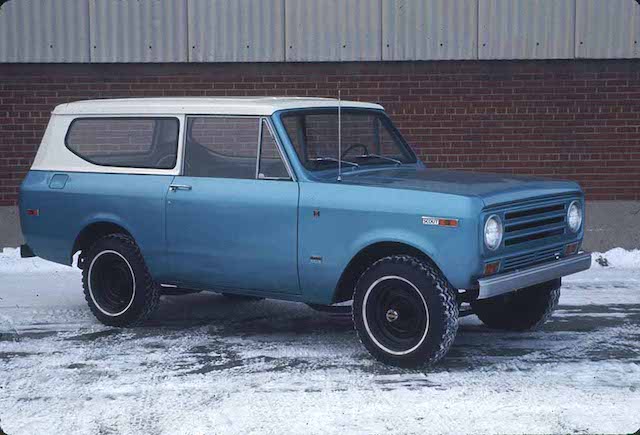
The image above is of one of the earliest running prototypes from 1968. Things to notice are the recessed gas filler on the passenger side, which was part of the earliest concepts but cost considerations kept it from production. In production, the cap was external and on the driver's side. Note also the badging and placement of it, then compare this to the other images you will see farther on. Still, the general look is there and even the color, Aegean Blue Metallic. Another thing to notice is that the first prototype Scouts used Ford Bronco-style Dana 30 front axles with internally spline hubs. Later, Dana-Spicer would develop a more generic axle for Scout with flanged hubs. Photo courtesy of Wisconsin Historical Society; WHS110358.
It's All in the Name
X-Scout was the working name but as the '60s began to close and the end was in sight, other names were bandied about. Following the previous conventions, a designation that floated to the top was 810. The first Scout was the 80, the update was the 800 (later the 800A and 800B interim models), so 810 made sense. Thing is, it was insufficiently whizbang for a totally new model.
The 810 idea had gone far enough in the process that some badging had been produced and decals printed, but on December 3, 1970, it was decided to use the 810 designation only as an internal term but to adopt Scout II as the primary marketing name. A short-term legacy in '71 was a GVW placard in the glovebox that listed 810 as the model. It faded away as those decals were used up and replaced with one marked "Scout II" towards the end of the model year. Indications are this happened in the mid-July timeframe.
The Debut Shindig and a Late Start on Sales
The Scout II took it's first bows at the San Marcos Hotel in Chandler, Arizona, April 20-23, 1971. Most of the Scouts seen were preproduction models, or prototypes that had been dolled up to appear like production models. Full-scale Scout II production didn't start until April 19, 1971, gearing up for a very late start to the sales season. Dealers were notified May 24 that the "Wow Wagon" sales campaign would start on June 24. Each dealer that sold Scouts would recieve at least one showroom/demo model and they wanted those Scouts to have an impact.
Many of the early production Scouts were built to a particular "recipe" for maximum impact in dealer showrooms. The Line Setting Tickets (LST) were specially marked with "SHOW" and a number. Thus far, we have seen SHOW 1 (bare bones 4-cylinder Cabtop), Show 9 (well equipped 304 V8 automatic) and Show 10 (a 345 and everything but the kitchen sink). Logic would dictate that if SHOW 1 was a bare bones rig and SHOW 10 was the top-o-the-line, 2-9 would be a mix of trim and equipment. That theory is bolstered by the SHOW 9 example but we are still studying LST to get a sense of the variations.
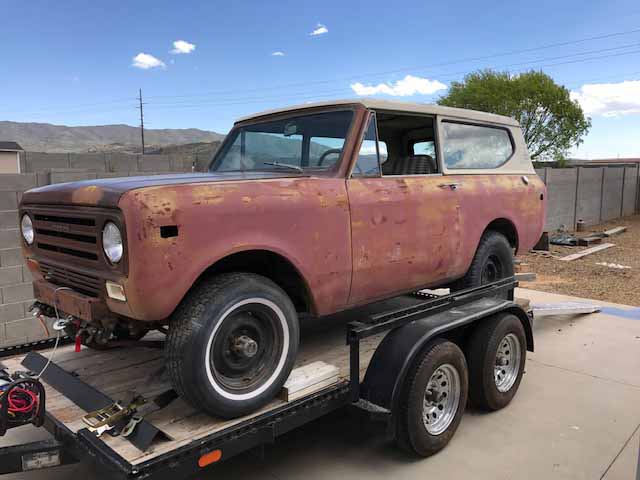
What you see above is the 24th Pilot Model Scout II that ran off the line March 30, 1971. It's the only preproduction Scout II known to survive and the earliest known Scout II. Bill Merritt found it in an Arizona impound yard and it's partway through a restoration. It was built as a standard trim Traveltop in 4394 Sundance Yellow. It was powered by a 345 backed up by a T45 close ratio 4-speed and an open Dana 44 rear with 3.31:1 axle ratios. One of a five unit order, it was sent to the Phoenix IH dealer in preparation for the big Scout II intro in Chandler late in April. In the process of the teardown, Bill found evidence that the badging locations had been altered from something more like the early prototype to the final layout. We can only speculate as to why the holes are in different locations. Since we know the badging was changed relatively late in the process, the likely theory is that the fenders were built to an earlier pattern and then altered to match the latest layout. Photo by William Merritt
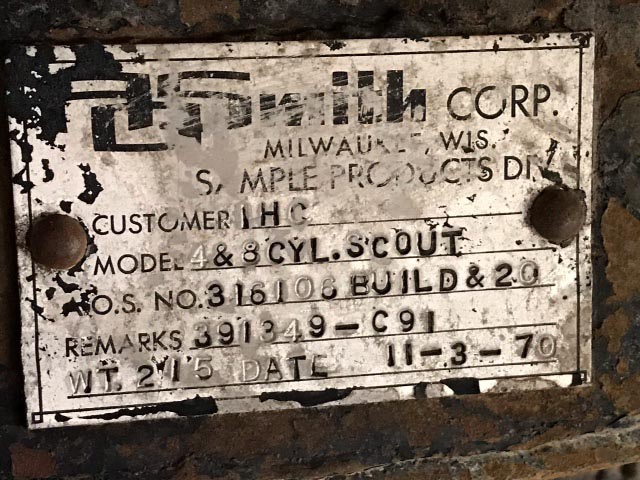
A.O. Smith had long built the chassis for Scouts. The chassis for Bill Merritt's #24 pilot model has a prototype tag from A.O. Smith dating it to November 3, 1970. Photo by William Merritt
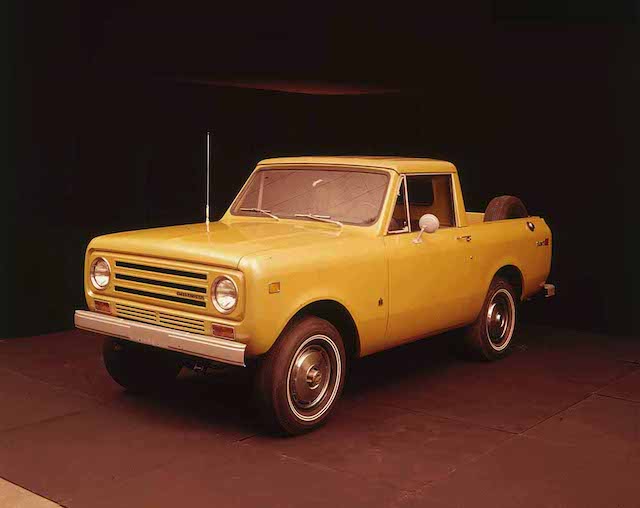
Above is another preproduction Scout, a Cabtop, built in a similar timeframe to Bill Merritt's and photographed at IH's Hickory Hills Farm, which was a working farm where IH kept a studio and did a lot of their photography over the years. It illustrates the standard exterior trim, with painted bumpers, no bright surrounds for the grille openings, no body side trim and no bright trim around the windows and taillights. This is the same Sundance Yellow paint as originally on Bill Merritt's preprod. Photo courtesy of Wisconsin Historical Society; WHS111021.
Another preprod, this time a full-boat Traveltop in Flame Red (2289) photographed at the Hickory Hills Farm and used in various advertising venues. Photo courtesy of Wisconsin Historical Society; WHS111387.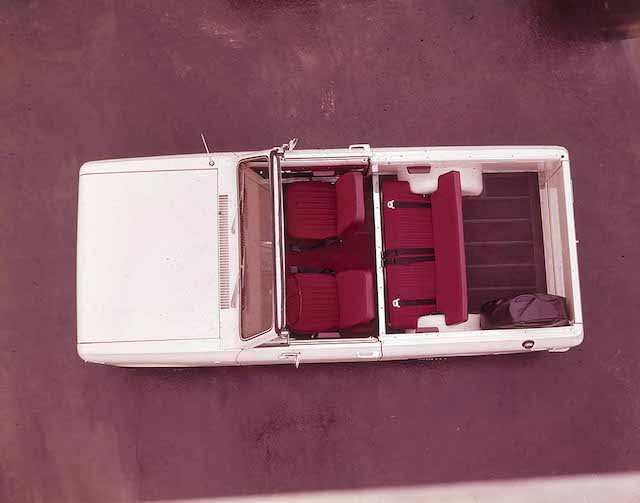
The Scout interior was a marked improvement over the previous generations. With the top removed for a picture at Hickory Hills, the image highlights the updates that put the Scout II at the top of the two-door SUV class when it debuted. This image appears in the first Scout II brochure. Photo courtesy of Wisconsin Historical Society; WHS11388.
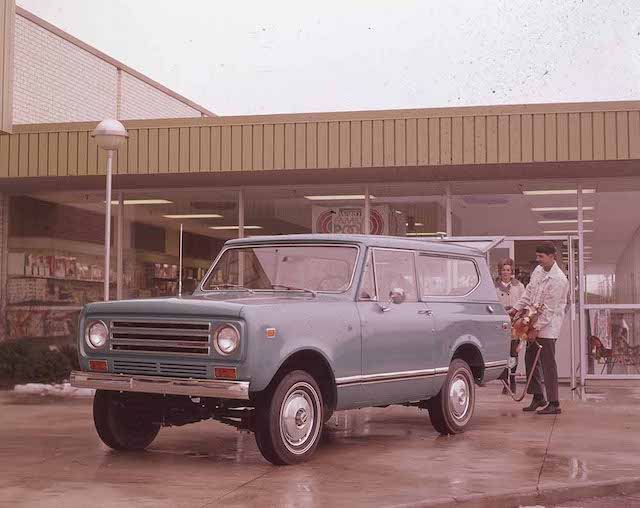
Loading up the Scout at "Monkey" Wards... period slang term for the long defunct Montgomery Ward department store chain. Again, this is a Scout II with a Deluxe Exterior. Photo courtesy of Wisconsin Historical Society; WHS111392.
Differences Between a 1971 and Later Scout IIs
Many of the differences were mechanical. The '71 model year was the last for the 232 ci six, sourced from American Motors. It was replaced for '72 by the 258 ci AMC six. Actually, there appear to have been a few '71s built with the 258 as stocks of the 232 ran out. The 1971 model year was the last run for Borg-Warner 3-speed automatics in the Scout. The T39 was used for the six and 304ci V8, and the beefier T49 was used with the 345 V8. The addition of the 345 ci V8 offered market parity with the 350 ci Blazer and beat the 302 ci Bronco. Of course it wasn't long until Blazer was offered with 400 and 454ci V8s, so the glory was fleeting. International contemplated adding the big 392 ci V8 to the line, but the engine plant was going full bore and most of those were engines earmarked for the medium-duty lines. Plus, emissions certification costs added to the list of negatives to counter the dubious benefits of the big engine.
Cosmetically, very little changed between '71 and '72. One very noticeable difference was the grille color, which went from body color in '71 to silver-gray for '72. This had less to do with any styling motivations than it did to simply production. Not having to paint grilles body color eased a paint shop bottleneck. One color changed occurred, Aegean Blue Metallic (6756) was replaced by Cosmic Blue (6766) for '72.
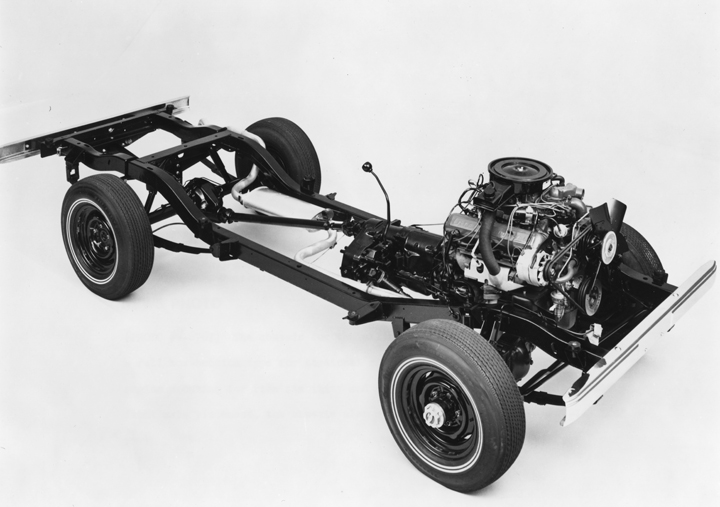
The Scout II chassis was loaded with beef. Fully boxed, it was one of the strongest SUV chassis on the market at the time. A preproduction chassis , it's shown with four-wheel drive, a 345 ci V8, backed up by a T49 Borg Warner automatic and single stick Dana 20 transfer case.
Abbreviated Model Year= Low Production
Between the Scout 800B being in production until March of 1971 and Scout II production not starting until April 19, a relatively low number of '71 model year Scout IIs were produced—approximately 14,152. Excluding the final and strike-abbreviated 1980 model year, that's about 33 percent fewer than the lowest Scout II production year. Shipments to dealers was deliberately slowed to allow for the 800B models to be sold off at bargain prices. The 1972 model year ramped up to 30,820 units.
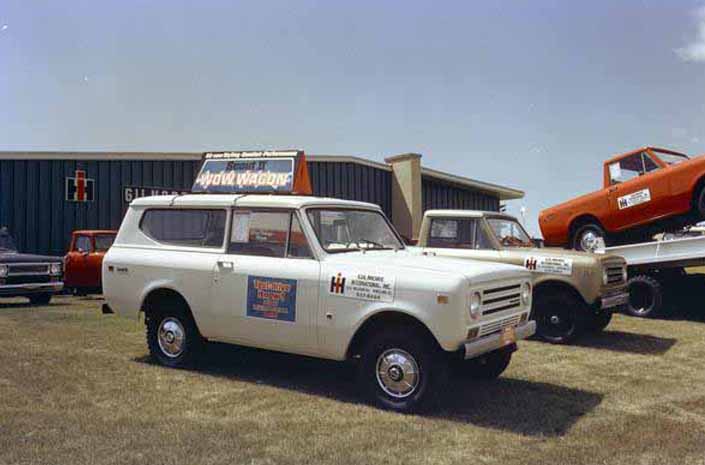
"WOW WAGON" indeed! Parked out front of Gilmore Implement in the summer of 1971 is a Scout II in Alpine White and the standard exterior. The base exterior Scout didn't come with hubcaps, so the dealer installed some from the light truck line to dress it up a little. These hubcaps did see some use in the last couple of years of the Scout 800A and 800B lines, but a new design was used for the Scout II when it debuted. Photo courtesy of Wisconsin Historical Society; WHS25636.
The Pure Thinking
The '71 Scout II makes for interesting study because it mostly closely represents the original thinking and design. It was a model that really hit the ground running for IH as well because it didn't have any notable teething issues and attracted a lot of attention. With a little more corporate intestinal fortitude and a whole lot more luck, the Scout II could have evolved into a model that might still be in production today.
.
A very early and nearly original Scout II survivor. It was bought by Bou-Matar family in Western Colorado from the original owner in 1996 and maintained very well over the years. It's in the stunning Aegean Blue Metallic, a 1971-only color. It's a Show Model 10 as mentioned above in the text, meaning it was the top-line build configuration.

